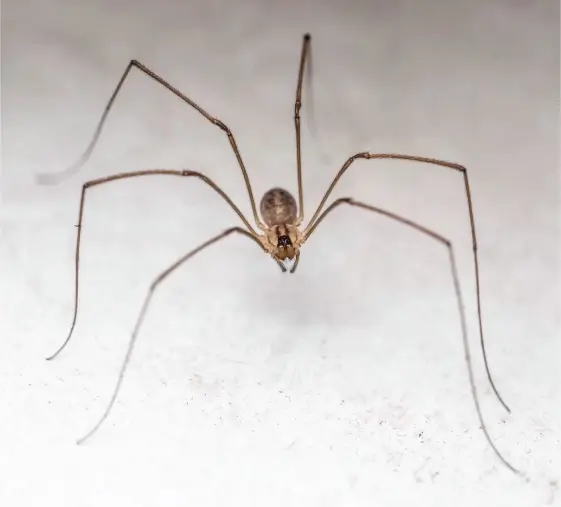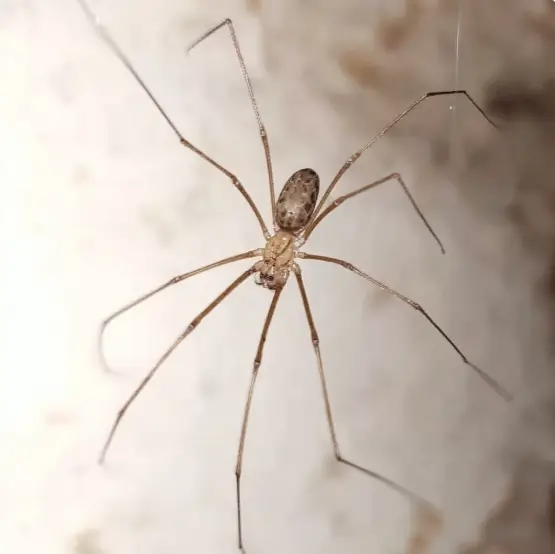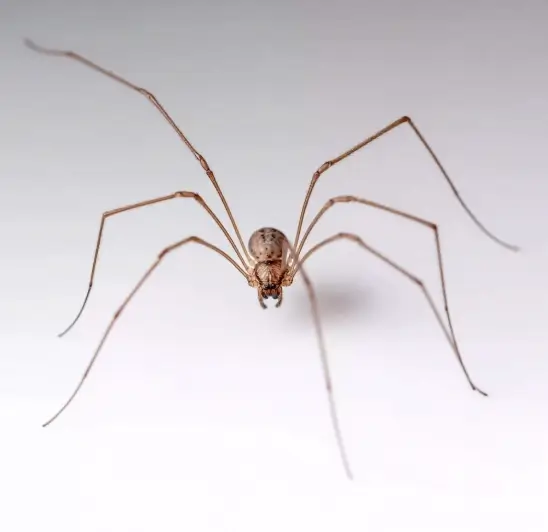
Cellar Spiders
Cellar spiders—often confused with the “daddy long legs” are one of the most frequently encountered arachnids in homes.
These spiders are easily identified by their small bodies and extremely long, thin legs. While their appearance might startle some, these spiders are generally harmless to humans and can even be helpful by reducing populations of other insects.
Table of Contents
What Are Cellar Spiders?
Cellar spiders is the common name for the spider belonging to the family Pholcidae, with one of the most common cellar spider species being Pholcus phalangioides, also known as the long-bodied cellar spider.

These arachnids are often confused with harvestmen (the true daddy long legs spider), but they are distinct spiders with segmented bodies, silk-producing capabilities, thin legs, and the ability to spin webs. The female has a body length of around eight millimeters, though the male tends to be a bit smaller.
They are commonly found in cellars, basements, garages, and crevices in ceilings and walls. Their webs are irregular, messy, and typically placed in corners or near ceilings where they can trap a variety of prey.
Where Are Cellar Spiders Found?
These spiders thrive in cool, dark, and undisturbed areas like basements, cellars, crawl spaces, attics, and closets. Cellar spiders also build webs in warm, humid spaces like bathrooms and laundry rooms. Commonly found in homes throughout North America, they’re especially frequent in houses with basements or older construction with plenty of nooks and crevices.

You might see them hanging upside down in their webs, often in corners or near the ceiling. Their preference for out-of-the-way spaces means many people live with cellar spiders without ever noticing them.
Dangers of Cellar Spiders
Despite their fearsome reputation, cellar spiders are completely harmless to humans. A popular myth suggests that their venom is potent but their fangs are too short to puncture human skin. In truth, their fangs (or jaws) can bite, but they rarely do and their venom poses no real threat to humans.
How Venomous Are Cellar Spiders?

Cellar spiders do produce venom, which they use to subdue prey like insects and other spiders. However, their venom is not dangerous to humans or pets. There is no scientific evidence that pholcid venom can cause harm to human skin or tissue.
So, while they may look spooky with their long legs and delicate frames, cellar spiders are generally not considered venomous in the way a black widow or wolf spider might be.
Habitat and Prey of the Longbodied Cellar Spider
These spiders appear in homes primarily in search of prey and a stable environment. Cellars and basements provide ideal conditions: darkness, consistent temperatures, and plenty of small insects to feed on.
Cellar spiders eat insects like flies, mosquitoes, and even other spiders. They’ve been known to take down orb weavers, jumping spiders, and more, making them surprising little predators in your home.
They build messy webs in corners, ceiling crevices, and other quiet areas where prey might pass. If you have an influx of bugs, chances are cellar spiders will follow.
Life Cycle and Behavior
Egg Sacs and Reproduction
Female cellar spiders produce multiple egg sacs during their lifetime, each holding up to 60 eggs. These sacs are often held in the spider’s mouth until they hatch, an unusual behavior in the arachnid world.
After hatching, spiderlings disperse to find their own corners and crevices. The entire life cycle from egg to adult may last several months to a year depending on conditions.
Web Construction and Movement
Cellar spiders spin irregular webs and stay close to them. If disturbed, they vibrate rapidly in their webs as a defense mechanism. This motion blurs their outline and can confuse predators.
Their webs are made from fine silk and usually span small corners or spaces near the ceiling. Though not beautiful like orb weavers' symmetrical designs, the messy nature of their webs makes them highly effective at catching prey.
Common Misconceptions About Cellar Spiders
The cellar spider is one of the most misunderstood arachnids around; here are just a few of the most common myths:
Myth: Cellar Spiders Have Potent Venom
The idea that cellar spiders have potent venom but can’t puncture human skin is false. While they do have venom to immobilize prey, it is not potent enough to harm humans, nor is their bite capable of serious injury.
Myth: They Are the Same as Harvestmen
Although they share the nickname daddy long legs, harvestmen and cellar spiders are different arachnids. Harvestmen (also called crane flies in error) lack silk glands, fangs, and venom.
Myth: You Should Always Remove Them
Whether or not you remove cellar spiders is a personal choice. Since they eat insects and other spiders, they may actually reduce pest populations. However, their webs can create an untidy appearance and trigger arachnophobia.
Should You Get Rid of Cellar Spiders?
It depends on your comfort level. While they pose no direct threat like other spiders that might be poisonous, their presence may signal an underlying insect problem. If you're seeing a large number of cellar spiders, you may want to consider an inspection for other pests.
A-1 Pest Control offers safe, eco-friendly solutions for managing cellar spiders and the insects they feed on. Our treatments target both the spiders and their food sources, ensuring lasting results.
FAQ: Cellar Spiders
Is it bad to have cellar spiders in your house?
Not necessarily. They’re harmless and may help control other insect pests. However, if you don’t want them in your home, we can safely remove them.
How venomous are cellar spiders?
They have venom to subdue prey, but it’s harmless to humans and pets.
Should you get rid of cellar spiders?
That depends on personal preference. Some people prefer to leave them, while others want a cleaner, spider-free space.
Why do cellar spiders appear?
They are attracted to dark, quiet spaces and the presence of other insects they can eat.

